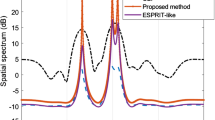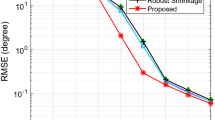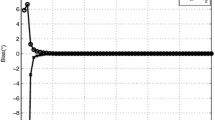Abstract
In this work, we present direction-of-arrival (DoA) estimation algorithms based on the Krylov subspace that effectively exploit prior knowledge of the signals that impinge on a sensor array. The proposed multi-step knowledge-aided iterative conjugate gradient (CG) (MS-KAI-CG) algorithms perform subtraction of the unwanted terms found in the estimated covariance matrix of the sensor data. Furthermore, we develop a version of MS-KAI-CG equipped with forward–backward averaging, called MS-KAI-CG-FB, which is appropriate for scenarios with correlated signals. Unlike current knowledge-aided methods, which take advantage of known DoAs to enhance the estimation of the covariance matrix of the input data, the MS-KAI-CG algorithms take advantage of the knowledge of the structure of the forward–backward smoothed covariance matrix and its disturbance terms. Simulations with both uncorrelated and correlated signals show that the MS-KAI-CG algorithms outperform existing techniques.







Similar content being viewed by others
References
A. Barabell, Performance of orthogonal matching pursuit for multiple measurement vectors with noise, in IEEE International Conference on Acoustics, Speech and Signal Processing (April 1983), pp. 336–339
G. Golub, C.V. Loan, Matrix Computations (Johns Hopkins University Press, Baltimore, 1996)
R. Grover, D. Pados, M. Medley, Subspace direction finding with an auxiliary-vector basis. IEEE Trans. Signal Process. 55(2), 758–763 (2007)
J.L. Jr, T. Rappaport, Smart antennas for Wireless Communications: IS-95 and Third Generation CDMA Applications (Prentice Hall, Upper Saddle River, 1999)
P. Pal, P. Vaidyanathan, A novel approach to array processing with enhanced degrees of freedom. IEEE Trans. Signal Process. 58(8), 4167–4181 (2010)
P. Pal, P. Vaidyanathan, Sparse sensing with co-prime samplers and arrays. IEEE Trans. Signal Process. 59(2), 573–586 (2011)
S. Pillai, B. Kwon, Forward/backward spatial smoothing techniques for coherent signal identification. IEEE Trans. Acoust. Speech Signal Process. 37(1), 8–15 (1989)
S. Pinto, R. de Lamare, Two-step knowledge-aided iterative ESPRIT algorithm, in IEEE Twenty First ITG Workshop on Smart Antennas (Berlin, March 2017), pp. 1–5
S. Pinto, R. de Lamare, Multi-step knowledge-aided iterative ESPRIT for direction finding, in IEEE 22nd International Conference on Digital Signal Processing (London, August 2017), pp. 1–5
S. Pinto, R. de Lamare, Knowledge-aided parameter estimation based on Conjugate Gradient algorithms, in 35th Brazilian Communications and Signal Processing Symposium (Sao Pedro, SP, Brazil, August 2017), pp. 1–5
S. Pinto, R. de Lamare, Multi-step knowledge-aided iterative Conjugate Gradient for direction finding, in IEEE 22nd ITG Workshop on Smart Antennas (Bochum, March 2018), pp. 1–5
S. Pinto, R. de Lamare, Multi-step knowledge-aided iterative ESPRIT: design and analysis. IEEE Trans. Aerosp. Electron. Syst. 54(5), 2189–2201 (2018b)
L. Qiu, R. de Lamare, M. Zhao, Reduced-rank DOA estimation algorithms based on alternating low-rank decomposition. IEEE Signal Process. Lett. 23(5), 565–569 (2016)
J. Rissanen, Modeling by the shortest data description. Automatica 14(6), 465–471 (1978)
R. Roy, T. Kailath, Estimation of signal parameter via rotational invariance technique. IEEE Trans. Acoust. Speech Signal Process. 37(7), 984–995 (1989)
S. Schell, W. Gardner, High Resolution Direction Finding—Handbook of Statistics (Elsevier, Amsterdam, 1993)
R. Schmidt, Multiple emitter location and signal parameter estimation. IEEE Trans. Antennas Propag. 34, 276–280 (1986)
H. Semira, H. Belkacemi, S. Marcos, High-resolution source localization algorithm based on the conjugate gradient. EURASIP J. Adv. Signal Process. 2007(2), 12 (2007)
M. Shaghaghi, S. Vorobyov, Iterative root-MUSIC algorithm for DOA estimation, in IEEE 5th International Workshop on Computational Advances in Multisensor Adaptive Processing (St. Martin, France, December 2013), pp. 1–4
M. Shaghaghi, S. Vorobyov, Subspace leakage analysis and improved DOA estimation with small sample size. IEEE Trans. Signal Process. 63(12), 3251–3265 (2015)
Z. Shi, C. Zhou, Y. Gu, N.A. Goodman, F. Qu, Source estimation using coprime array: a sparse reconstruction perspective. IEEE Sens. J. 17(3), 755–765 (2017)
J. Steinwandt, R. de Lamare, M. Haardt, Knowledge-aided direction finding based on Unitary ESPRIT, in IEEE 45th Asilomar Conference on Signals, Systems and Computers (Pacific Grove, CA, USA, November 2011), pp. 613–617
J. Steinwandt, R. de Lamare, M. Haardt, Beamspace direction finding based on the conjugate gradient algorithm, in 2011 International ITG Workshop on Smart Antennas (Aachen, Germany, February 2011), pp. 1–5
J. Steinwandt, R. de Lamare, M. Haardt, Beamspace direction finding based on the conjugate gradient and the auxiliary vector filtering algorithms. Signal Process. 93(4), 641–651 (2013)
P. Stoica, A. Gershman, Maximum-likelihood DOA estimation by data-supported grid search. IEEE Signal Process. Lett. 6(10), 273–275 (1999)
P. Stoica, A. Nehorai, MUSIC, maximum likelihood, and Cramér–Rao bound. IEEE Trans. Acoust. Speech Signal Process. 37(5), 720–741 (1989)
P. Stoica, A. Nehorai, Performance study of conditional and unconditional direction-of-arrival estimation. IEEE Trans. Acoust. Speech Signal Process. 38(10), 1783–1795 (1990)
P. Stoica, X. Zhu, J. Guerci, On using a priori knowledge in space-time adaptive processing. IEEE Trans. Signal Process. 56(6), 2598–2602 (2008)
A. Thakre, M. Haardt, K. Giridhar, Single snapshot spatial smoothing with improved effective array aperture. IEEE Signal Process. Lett. 16(6), 505–508 (2009)
H.V. Trees, Optimum Array Processing. Part IV of Detection, Estimation and Modulation Theory (Wiley, New York, 2002)
L. Wang, R. de Lamare, M. Haardt, Direction finding algorithms based on joint iterative subspace optimization. IEEE Trans. Aerosp. Electron. Syst. 50(4), 2541–2553 (2014)
C. Zhou, Y. Gu, Y. Zhang, Z. Shi, T. Jin, X. Wu, Compressive sensing-based coprime array direction-of-arrival estimation. IET Commun. 11(11), 1719–1724 (2017)
Author information
Authors and Affiliations
Corresponding author
Additional information
Publisher's Note
Springer Nature remains neutral with regard to jurisdictional claims in published maps and institutional affiliations.
Rights and permissions
About this article
Cite this article
Pinto, S.F.B., de Lamare, R.C. Multi-step Knowledge-Aided Iterative Conjugate Gradient Algorithms for DOA Estimation. Circuits Syst Signal Process 38, 3841–3859 (2019). https://doi.org/10.1007/s00034-019-01033-0
Received:
Revised:
Accepted:
Published:
Issue Date:
DOI: https://doi.org/10.1007/s00034-019-01033-0




